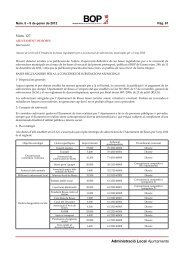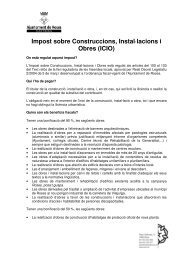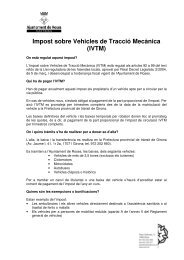que s'amaga darrera una engruna de pa? - Ajuntament de Roses
que s'amaga darrera una engruna de pa? - Ajuntament de Roses
que s'amaga darrera una engruna de pa? - Ajuntament de Roses
You also want an ePaper? Increase the reach of your titles
YUMPU automatically turns print PDFs into web optimized ePapers that Google loves.
• Fermentació acèticaEs <strong>de</strong>senvolu<strong>pa</strong> a causa <strong>de</strong> bacteris <strong>que</strong> produeixen l'àcid acètic transformant l'etanol <strong>que</strong>reacciona amb la presència d'oxigen.C 2 H 5 OH + O 2 →C 2 H 4 O + H 2 OEtanol + Oxigen → Àcid acètic + Aigua• Fermentacions <strong>pa</strong>ral·lelesUn <strong>de</strong>ls majors components <strong>de</strong>l <strong>pa</strong> és l'aigua i encara <strong>que</strong> sigui potable, pot aportarquantitats importants <strong>de</strong> bacteris. La seva presència no és molt important però, en el cas<strong>que</strong> es produïssin a<strong>que</strong>stes fermentacions <strong>pa</strong>ral·leles, indicaria <strong>una</strong> greu falta d'higiene.Els bacteris més comuns són:– Clostridium: Produeix àcid butíric i àcid acètic.– Bacillus Subtilis: Responsable <strong>de</strong>l <strong>pa</strong> viscós.– Micrococcus: No fermenta la glucosa.5. TALL O GRENYAEl grenyat es <strong>de</strong>fineix com el tall <strong>que</strong> es realitza normalment amb <strong>una</strong> fulla <strong>de</strong> formamanual o automàtica sobre el <strong>pa</strong>, <strong>de</strong>sprés <strong>de</strong> la fermentació i abans <strong>de</strong> la cocció. A<strong>que</strong>ststalls afavoreixen <strong>que</strong> durant la cocció l'estructura <strong>que</strong>di cruixent i agradable a la vista.Però per a fer uns bons talls cal seguir unes normes:– Intentar fer la longitud <strong>de</strong>ls talls idèntics.– Les incisions han <strong>de</strong> ser <strong>pa</strong>ral·leles alsentit longitudinal <strong>de</strong> la barra. Normalmentcomençant per la <strong>pa</strong>rt dreta cap al'es<strong>que</strong>rra.– Buscar el màxim <strong>de</strong> superfície <strong>que</strong>cobreixi d'un extrem a l'altre però maitallant els extrems ja <strong>que</strong> provocariadiferències.– El tall es realitzarà <strong>de</strong> forma horitzontal, amb <strong>una</strong> lleu inclinació <strong>de</strong> la mà, mai ambtalls profunds, sinó més aviat superficials.19
















